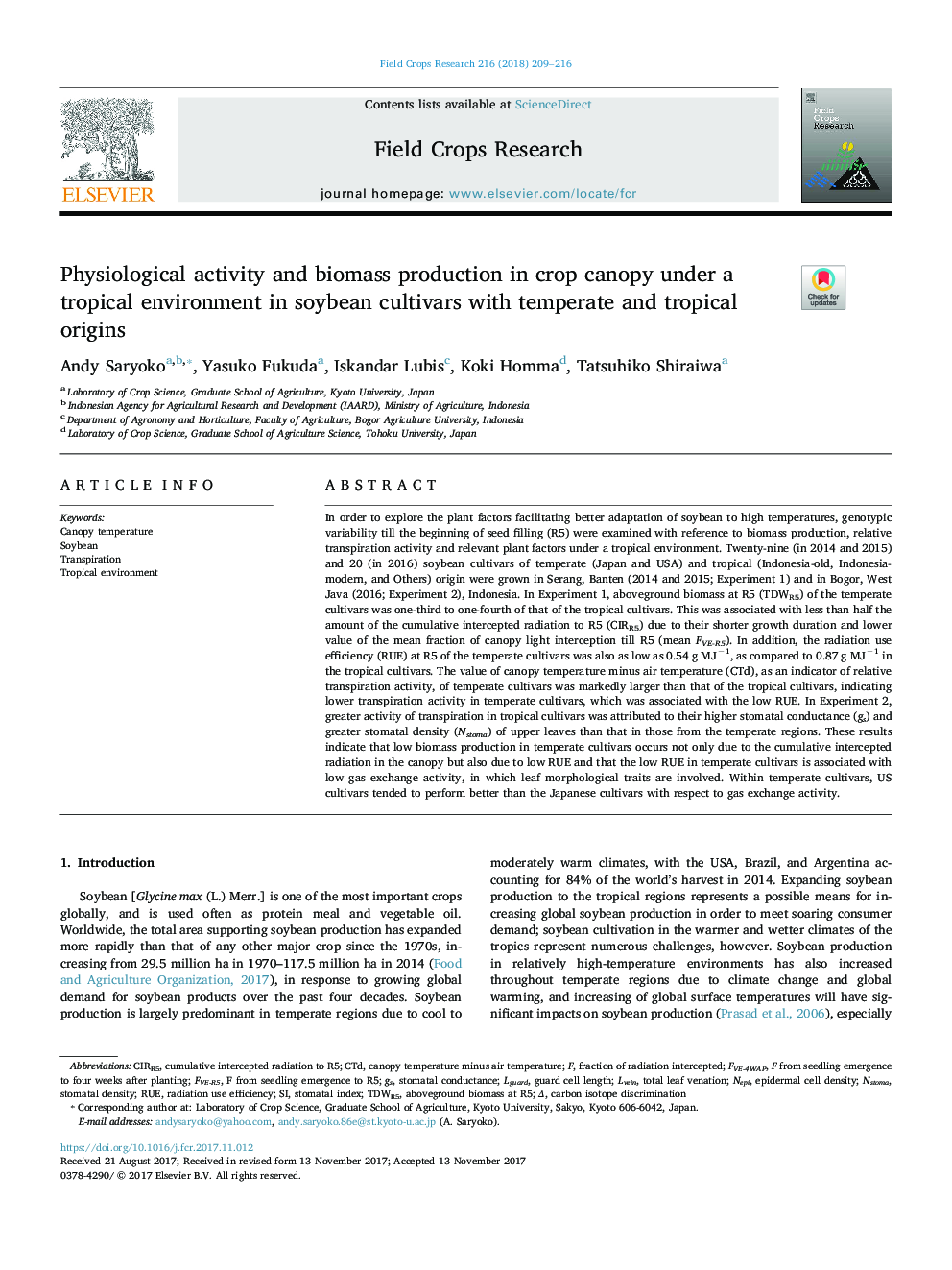| کد مقاله | کد نشریه | سال انتشار | مقاله انگلیسی | نسخه تمام متن |
|---|---|---|---|---|
| 8879445 | 1624647 | 2018 | 8 صفحه PDF | دانلود رایگان |
عنوان انگلیسی مقاله ISI
Physiological activity and biomass production in crop canopy under a tropical environment in soybean cultivars with temperate and tropical origins
ترجمه فارسی عنوان
فعالیت فیزیولوژیکی و تولید زیست توده در سایبان محصول تحت یک محیط گرمسیری در ارقام سویا با ریشه های معتدل و
دانلود مقاله + سفارش ترجمه
دانلود مقاله ISI انگلیسی
رایگان برای ایرانیان
کلمات کلیدی
CTDNEPIRadiation use efficiency - بهره وری استفاده از تابشcarbon isotope discrimination - تبعیض ایزوتوپ کربنStomatal density - تراکم دهانTranspiration - تعرقCanopy temperature - دمای سایبانRUE - روپیهSoybean - سویاstomatal index - شاخص تناسلیTropical environment - محیط گرمسیریStomatal conductance - هدایت گرمایشی
موضوعات مرتبط
علوم زیستی و بیوفناوری
علوم کشاورزی و بیولوژیک
علوم زراعت و اصلاح نباتات
چکیده انگلیسی
In order to explore the plant factors facilitating better adaptation of soybean to high temperatures, genotypic variability till the beginning of seed filling (R5) were examined with reference to biomass production, relative transpiration activity and relevant plant factors under a tropical environment. Twenty-nine (in 2014 and 2015) and 20 (in 2016) soybean cultivars of temperate (Japan and USA) and tropical (Indonesia-old, Indonesia-modern, and Others) origin were grown in Serang, Banten (2014 and 2015; Experiment 1) and in Bogor, West Java (2016; Experiment 2), Indonesia. In Experiment 1, aboveground biomass at R5 (TDWR5) of the temperate cultivars was one-third to one-fourth of that of the tropical cultivars. This was associated with less than half the amount of the cumulative intercepted radiation to R5 (CIRR5) due to their shorter growth duration and lower value of the mean fraction of canopy light interception till R5 (mean FVE-R5). In addition, the radiation use efficiency (RUE) at R5 of the temperate cultivars was also as low as 0.54 g MJâ1, as compared to 0.87 g MJâ1 in the tropical cultivars. The value of canopy temperature minus air temperature (CTd), as an indicator of relative transpiration activity, of temperate cultivars was markedly larger than that of the tropical cultivars, indicating lower transpiration activity in temperate cultivars, which was associated with the low RUE. In Experiment 2, greater activity of transpiration in tropical cultivars was attributed to their higher stomatal conductance (gs) and greater stomatal density (Nstoma) of upper leaves than that in those from the temperate regions. These results indicate that low biomass production in temperate cultivars occurs not only due to the cumulative intercepted radiation in the canopy but also due to low RUE and that the low RUE in temperate cultivars is associated with low gas exchange activity, in which leaf morphological traits are involved. Within temperate cultivars, US cultivars tended to perform better than the Japanese cultivars with respect to gas exchange activity.
ناشر
Database: Elsevier - ScienceDirect (ساینس دایرکت)
Journal: Field Crops Research - Volume 216, February 2018, Pages 209-216
Journal: Field Crops Research - Volume 216, February 2018, Pages 209-216
نویسندگان
Andy Saryoko, Yasuko Fukuda, Iskandar Lubis, Koki Homma, Tatsuhiko Shiraiwa,
